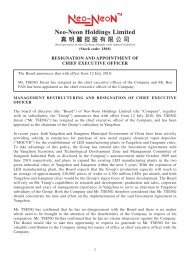Annual Report 2011 年 報 - Neo-Neon LED Lighting International Ltd
Annual Report 2011 年 報 - Neo-Neon LED Lighting International Ltd
Annual Report 2011 年 報 - Neo-Neon LED Lighting International Ltd
You also want an ePaper? Increase the reach of your titles
YUMPU automatically turns print PDFs into web optimized ePapers that Google loves.
NotES to tHE CoNSoLIDAtED<br />
fINANCIAL StAtEMENtS<br />
4. SIGNIFICANT ACCOUNTING POLICIES (Continued)<br />
Joint ventures<br />
Jointly controlled entities<br />
Joint venture arrangements that involve the establishment of a separate entity in which venturers have joint<br />
control over the economic activity of the entity are referred to as jointly controlled entities.<br />
The results and assets and liabilities of jointly controlled entities are incorporated in the consolidated financial<br />
statements using the equity method of accounting. Under the equity method, investments in jointly controlled<br />
entities are initially recognised in the consolidated statement of financial position at cost and adjusted<br />
thereafter to recognise the Group’s share of the profit or loss and other comprehensive income of the jointly<br />
controlled entities. When the Group’s share of losses of a jointly controlled entity equals or exceeds its<br />
interest in that jointly controlled entity (which includes any long-term interests that, in substance, form part<br />
of the Group’s net investment in the jointly controlled entity), the Group discontinues recognising its share<br />
of further losses. Additional losses are recognised only to the extent that the Group has incurred legal or<br />
constructive obligations or made payments on behalf of that jointly controlled entity.<br />
Any excess of the cost of acquisition over the Group’s share of the net fair value of the identifiable assets,<br />
liabilities and contingent liabilities of a jointly controlled entity recognised at the date of acquisition is<br />
recognised as goodwill, which is included within the carrying amount of the investment. Any excess of the<br />
Group’s share of the net fair value of the identifiable assets, liabilities and contingent liabilities over the cost<br />
of acquisition, after reassessment, is recognised immediately in profit or loss.<br />
The requirements of HKAS 39 are applied to determine whether it is necessary to recognise any impairment<br />
loss with respect to the Group’s investment in a jointly controlled entity. When necessary, the entire<br />
carrying amount of the investment (including goodwill) is tested for impairment in accordance with HKAS 36<br />
“Impairment of assets” as a single asset by comparing its recoverable amount (higher of value in use and fair<br />
value less costs to sell) with its carrying amount, Any impairment loss recognised forms part of the carrying<br />
amount of the investment. Any reversal of that impairment loss is recognised in accordance with HKAS 36 to<br />
the extent that the recoverable amount of the investment subsequently increases.<br />
From 1st January 2010 onwards, upon disposal of a jointly controlled entity that results in the Group losing<br />
joint control over that jointly controlled entity, any retained investment is measured at fair value at that date<br />
and the fair value is regarded as its fair value on initial recognition as a financial asset in accordance with<br />
HKAS 39. The difference between the previous carrying amount of the jointly controlled entity attributable<br />
to the retained interest and its fair value is included in the determination of the gain or loss on disposal of<br />
the jointly controlled entity. In addition, the Group accounts for all amounts previously recognised in other<br />
comprehensive income in relation to that jointly controlled entity on the same basis as would be required if<br />
that associate had directly disposed of the related assets or liabilities. Therefore, if a gain or loss previously<br />
recognised in other comprehensive income by that jointly controlled entity would be reclassified to profit or<br />
loss on the disposal of the related assets or liabilities, the Group reclassifies the gain or loss from equity to<br />
profit or loss (as a reclassification adjustment) when it looses joint control over that jointly controlled entity.<br />
When a group entity transacts with its jointly controlled entity, profits and losses resulting from the<br />
transactions with the jointly controlled entity are recognised in the Group’ consolidated financial statements<br />
only to the extent of interests in the jointly controlled entity that are not related to the Group.<br />
ANNUAL REPORT <strong>2011</strong> 55




